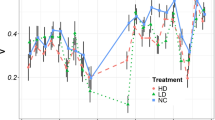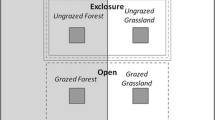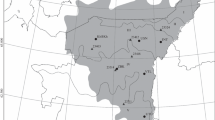Abstract
Permanent plots with a fine scale recording system were used to trace the spatiotemporal process within two mountain grasslands in the Krkonoše Mts., Czech Republic. The analysis used autocorrelation over increasing lags in space and/or time. Moran'sI was used to measure the autocorrelation. There was a lot of variation between species both in spatial and temporal correlograms. The spatiotemporal pattern of species correlated well with the growth form of the species and the degree of its clonality. Clonally-growing species tended to have high clumping at distances of a few cells, whereas rosette species often did not show any clumping. The type of clonal growth (compact vs. long spacers) is well corrlated, with the temporal correlogram (species mobility). There is a relation between low mobility and high clumping at low distances. Attempts to explain the mechanisms of species coexistence in these grasslands should take into account the particular structure of the fine-scale dynamics of these communities of predominantly clonal plants. *** DIRECT SUPPORT *** A02DO006 00007
Similar content being viewed by others
References
Bell A.D. (1984): Dynamic morphology: a contribution to plant population ecology.—In:Dirzo R. &Sarukhán J. (eds.), Perspectives on plant population biology, Sinauer Assoc., Sunderland, pp. 48–65.
Chesson P.L. &Warner R.R. (1981): Environmental variability promotes coexistence in lottery competitive systems.—Amer. Naturalist 117: 923–956.
Czárán T. &Bartha S. (1992): Spatiotemporal models of plant populations and communities.—Trends Ecol. Evol. 7: 38–42.
Greig-Smith P. (1979): Pattern in vegetation.—J. Ecol. 67: 755–779.
Grime J.P., Hodgson J.G. &Hunt R. (1988): Comparative plant ecology: a functional approach to common British species.—Unwin Hyman, London.
Herben T., Krahulec F., Hadincová V. &Kovářová M. (1990): Small scale dynamics in a mountain grassland.—In:Krahulec F., Agnew A.D.Q., Agnew S. &Willems J.H. [eds.]: Spatial processes in plant communities, Academia, Prague & The Hague, pp. 173–184.
Herben T., Krahulec F., Hadincová V. &Kovářová M. (1993): Fine scale spatial dynamics of plant species in a grassland community during six years.—J. Veg. Sci. 4: 171–178.
Hutchings M.J. &de Kroon H. (1994): Foraging in plants: the role of morphological plasticity in resource acquisition.—Advances Ecol. Res. 25: 159–238.
Kershaw K.A. (1958): An investigation of the structure of a grassland community I. The pattern ofAgrostis tenuis.—J. Ecol. 46: 571–592.
Krahulec F. (1990):Nardo-Agrostion communities in the Krkonoše and West Carpathians Mts.—Folia Geobot. Phytotax. 25: 337–347.
Law R., McLellan A. &Mahdi A.S. (1994): Spatiotemporal processes in a calcareous grassland.— Pl. Spec. Biol. 8: 175–193.
Lovett Doust L. &Lovett Doust J. (1985): The battle strategies of plants.—New Phytol. 95: 81–85.
Mahdi A. &Law R. (1987): On the spatial organisation of plant species in a limestone grassland community. —J. Ecol. 75: 459–476.
Oborny B. (1994a): Growth rules in clonal plants and predictability of the environment: a simulation study. —J. Ecol. 82: 341–351.
Oborny B. (1994b): Spacer length in clonal plants and the efficiency of resource capture in heterogeneous environments: a Monte Carlo simulation.—Folia Geobot. Phytotax. 29: 139–158.
Prach K. &Pyšek P. (1994): Clonal plants—what is their role in succession?—Folia Geobot. Phytotax. 29: 307–320.
Schmid B. &Harper J.L. (1985): Clonal growth in grassland perennials. I. Density and pattern dependent competition between plants of different growth forms.—J. Ecol. 73: 793–808.
Schmid B. (1990): Some ecological and evolutionary consequences of modular organization and clonal growth in plants.—Evol. Trends Pl. 4: 25–34.
Sykes M.T., van der Maarel E., Peet R.K. &Willems J.H. (1994): High species mobility in species-rich plant communities: an intercontinental comparison.—Folia Geobot. Phytotax. 29: 439–448.
Thórhalsdóttir T.E. (1990): The dynamics of a grassland community: a simultaneous investigation of spatial and temporal heterogeneity at various scales.—J. Ecol. 78: 884–908.
Turkington R. (1989): The growth, distribution and neighbour relationship ofTrifolium repens in a permanent pasture. VI. Conditioning effects of neighbours.—J. Ecol. 77: 734–746.
Turkington R., Sackville Hamilton R. &Gliddon C. (1991): Within population variation in localized and integrated responses ofTrifolium repens to biotically patchy environments.—Oecologia 86: 183–192.
Tutin T.G. et al. (1964-1980): Flora Europaea.—Cambridge University Press, Cambridge.
Upton G.J.G. &Fingleton B. (1985): Spatial data analysis by example. Vol. I. Point pattern and quantitative data.—Wiley & Sons, Chichester.
van der Hoeven E.C., de Kroon H. &During H.J. (1990): Fine-scale spatial distribution of leaves and shoots of two chalk grassland perennials.—Vegetatio 86: 151–160.
van der Maarel E. &Sykes M. T. (1993): Small scale plant species turnover in a limestone grassland: the carousel model and some comments on the niche concept.—J. Veg. Sci. 4: 179–188.
Werger M.J.A., During H.J. &van Rijnberk H. (1987): Leaf diversity of three vegetation types of Tenerife, Canary Islands.—In:Huiskes A.H.L., Blom C.W.P.M. &Rozema J. [eds.]: Vegetation between land and sea, Junk, Dordrecht, pp. 107–118.
Wilson J.B. &Roxburgh S.H. (1994): A demonstration of guild-based assembly rules for a plant community, and determination of intrinsic guilds.—Oikos 69: 267–276.
Author information
Authors and Affiliations
Corresponding author
Rights and permissions
About this article
Cite this article
Herben, T., During, H.J. & Krahulec, F. Spatiotemporal dynamics in mountain grasslands: Species autocorrelations in space and time. Folia Geobot 30, 185–196 (1995). https://doi.org/10.1007/BF02812097
Issue Date:
DOI: https://doi.org/10.1007/BF02812097




